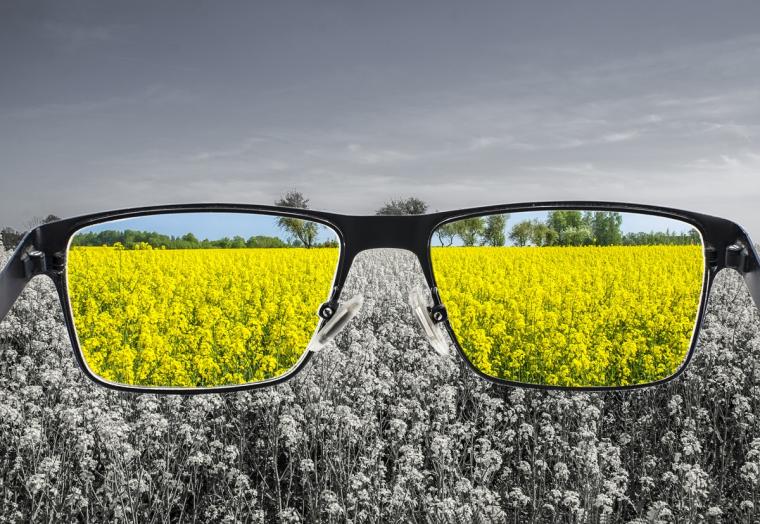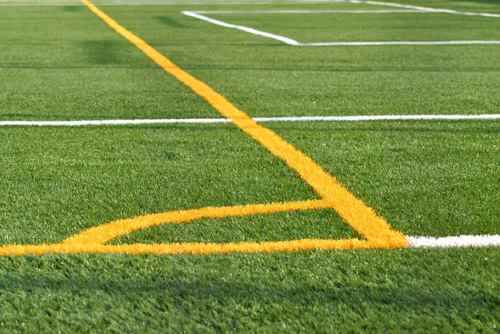
The advent of corrective lenses for those who suffer from color-blindness has been touted as a miracle cure; however, studies have shown they do not work for all individuals; in addition, some say they cause headaches.
A lot of time has been spent discussing how many advances have been made in designing sports venues to accommodate those with physical and developmental challenges. In one area, though, work is still needed: accommodating athletes with color-blindness.
Compounding the problem is an ongoing disagreement over whether color-blindness constitutes a disability. While many think of it as an inability to see color entirely (in other words, to literally view the world in shades of black and white, like an old movie), there are various types of color-blindness (or, perhaps more correctly, color vision deficiency, CVD for short). According to the website of the National Eye Institute (a part of NIH), they are as follows:
Red-green color vision deficiency
As the name suggests, this makes it hard to tell the difference between red and green. There are four types of red-green color vision deficiency:
- Deuteranomaly is the most common type of red-green color vision deficiency. It makes certain shades of green look more red. This type is mild and doesn’t usually get in the way of normal activities.
- Protanomaly makes certain shades of red look more green and less bright. This type is mild and usually doesn’t get in the way of normal activities.
- Protanopia and Deuteranopia both make someone unable to tell the difference between red and green at all.
Blue-yellow color vision deficiency
This less-common type of color vision deficiency makes it hard to tell the difference between several different color combinations. There are two types of blue-yellow color vision deficiency:
- Tritanomaly makes it hard to tell the difference between blue and green, and between yellow and red.
- Tritanopia makes someone unable to tell the difference between blue and green, purple and red, and yellow and pink. It also makes colors look less bright.
Complete color vision deficiency
Those with this type of color-blindness (which is rare) cannot discern colors at all. This is also called monochromacy or achromatopsia.
Want to know exactly what sports look like to those with color vision deficiency? Here are some great examples of action shots of sports, which have been altered to show why (and how) it is such a problem.
Color-blindness, which is hereditary (although there are rare exceptions) is generally more prevalent in males than females; according to the British website, Colour Blind Awareness (CBA), approximately one in 12 males and one in 200 females are color-blind. In the USA, 13 million people are color-blind. (Trivia point: Many athletes, including NFL running back Christian McCaffrey and golfers Tiger Woods and Jack Nicklaus, as well as baseball players Derek Jeter and Babe Ruth, and swimmer Michael Phelps, have succeeded despite their color-blindness. Many developed workarounds, recounted here).
In some ways, color-blindness is an invisible handicap. Those who have it may not know it, and those who know it may hide it for fear of being ridiculed, looked down on or labeled as handicapped (and in the case of sports, excluded from competing). Some coaches develop workarounds for players who have color-blindness, such as having all girls on the same soccer team wear bandanas. In fact, there are websites with sections entirely devoted to strategies on how to handle color-blindness and continue to play.

The question, of course, is begging to be asked: What does this have to do with sports tourism? A great deal, as it turns out. As communities become increasingly landlocked, fields, and particularly turf fields, are being lined for multiple sports, including soccer, football, lacrosse and field hockey.
To a person with color vision deficiency, many of these lines may not be visible, or may look exactly alike. Add to that the fact that turf now comes in a variety of colors – and that courts are often lined not just for tennis but for 30-foot and 60-foot youth play, as well as for pickleball – and you have a perfect storm of problems.
That means, given the law of averages and the exploding number of events on the market, and the likelihood that travel tournaments will include players with color vision deficiency, venues nationwide will likely have to deal with the issue sooner rather than later; becoming familiar with the problem, knowing some of the workarounds and being ready to put them into action can help avoid last-minute panics before a tournament begins.
One good development of the Information Age: It is possible to find out for free to see if you have any of the previously mentioned forms of color-blindness by taking a five-minute online exam.
CBA notes, “Color-blind players, coaches and match officials have the most to lose where sports do not take their needs into account; yet they are the group which has been ignored the most to date. At the grassroots level, young children can be put off playing sports simply because they can’t easily tell uniforms apart or see equipment clearly, but for those players who are dedicated to a specific sport, who play at a high level and who want to make that their profession, or are already playing at elite level, being color-blind has the potential to cost them their professional careers. Fear of being treated differently is the reason most color-blind players who have been diagnosed tend to hide their condition.”
Youth sports are starting to tackle the problem. USA Lacrosse notes, “Ball colors at the high school and youth level can be white, yellow, lime-green or orange for the boys’ game and yellow, lime-green or orange for the girl’s game. Lime green was added on the advice around color blindness for both games. Additionally, there is no restriction on the color of the lines on the fields as long as they are contrasting.”
The UEFA has gone so far as to develop a guidance booklet on color-blindness in soccer (which can be downloaded free here).
Additionally, one of the most difficult parts of color-blindness is getting the public to realize it is a problem, and that goes for spectators as well as for players. The NFL, for example, got a wake-up call in 2015 when it instituted its “Color Rush” campaign, in which players on both teams wore colored jerseys. (Generally, an NFL game has one team in white and another team wearing its home color.)
In one game, played on a Thursday night between the New York Jets and the Buffalo Bills, players wore uniforms in red and green – a nightmare for many viewers and players who had some type of color blindness, and who could not tell (or could not tell easily) the difference between players’ uniforms (or between their helmets, since both teams wore white headgear). Frustrated viewers took to social media, taking no prisoners in letting the world know how they felt, even posting greyscale images that showed what the game looked like to them, so that individuals with full vision could understand the problem. The NFL noted that it “didn’t account for color-blindness, will in future.”
The NFL isn’t alone. A 2018 FIFA World Cup match had similar issues, and it’s a problem in ice hockey as well as baseball. Studies have even been done on the impact of color deficient vision upon cricket players.
In the meantime, those with color-blindness have continued to petition national officials for changes at the youth, college and professional levels, although it is still a tough battle to fight.
In 2010, the arrival of so-called “color-blind glasses,” generated a great deal of press; however, ophthalmologists have been quick to note that such glasses don't actually correct or cure color-blindness by making the world go from black and white to Technicolor (we’re looking at you, Wizard of Oz). They can make it easier for people with some forms of color-blindness to tell colors apart while they are wearing them, but depending upon the extent or type of color-blindness a person has, glasses may not have any effect. Additionally, some users complained of headaches, and some gave them up and went back to their other methods of coping.

